Chevrolet Cruze Repair Manual: Front Brake Rotor Replacement
Special Tools
- CH-41013 Rotor Resurfacing Kit
- CH-42450-A Wheel Hub Resurfacing Kit
For equivalent regional tools, refer to Special Tools.
Removal Procedure
Warning: Refer to Brake Dust Warning in the Preface section.
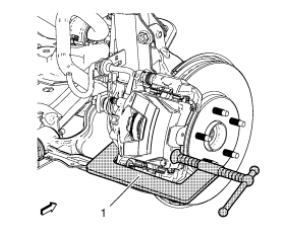
- Raise and support the vehicle. Refer to Lifting and Jacking the Vehicle.
- Remove the tire and wheel assembly. Refer to Tire and Wheel Removal and Installation.
- Install a C-clamp (1) over the body of the brake caliper, with the C-clamp ends against the rear of the caliper body and the outboard disc brake pad.
- Tighten the C-clamp (1) until the caliper piston is compressed into the caliper bore enough to allow the caliper to slide past the brake rotor.
- Remove the C-clamp (1).
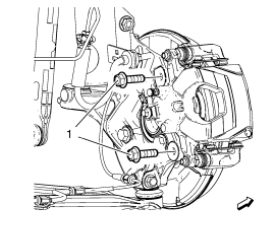
- Remove and DISCARD the brake caliper bracket bolts (1).
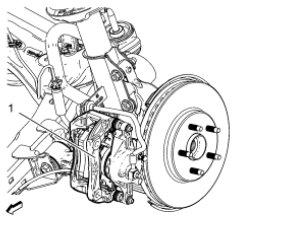
Caution: Support the brake caliper with heavy mechanic wire, or equivalent, whenever it is separated from its mount and the hydraulic flexible brake hose is still connected. Failure to support the caliper in this manner will cause the flexible brake hose to bear the weight of the caliper, which may cause damage to the brake hose and in turn may cause a brake fluid leak.
Note: Do NOT disconnect the hydraulic brake flexible hose from the caliper.
- Remove the brake caliper and the caliper mounting bracket as an assembly (1) from the steering knuckle and support the assembly with heavy mechanic's wire, or equivalent. Ensure that there is no tension on the hydraulic brake flexible hose.
- Matchmark the position of the brake rotor to the wheel studs.
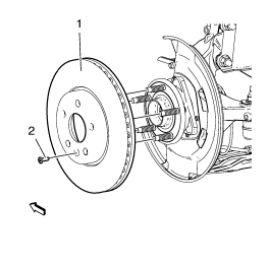
- Remove the brake rotor screw (2).
- Remove the brake rotor (1) from the wheel hub.
Installation Procedure
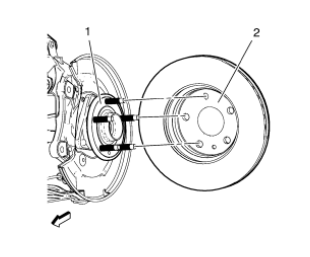
Note: Whenever the brake rotor has been separated from the hub/axle flange, any rust or contaminants should be cleaned from the hub/axle flange and the brake rotor mating surfaces. Failure to do this may result in excessive assembled lateral runout (LRO) of the brake rotor, which could lead to brake pulsation.
- Using the CH 42450-A resurfacer , thoroughly clean any rust or corrosion from the mating surface of the hub/axle flange (1).
- Using the CH 41013 resurfacer , thoroughly clean any rust or corrosion from the mating surface and mounting surface of the brake rotor (2).
- Inspect the mating surfaces of the hub/axle flange and the rotor to ensure that there are no foreign particles or debris remaining.
- Install the brake rotor to the hub/axle flange. Use the matchmark made prior to removal for proper orientation to the flange.
Caution: Refer to Fastener Caution in the Preface section.
- Install the brake rotor screw and tighten to 7 N·m (62 lb in).
- If the brake rotor was removed and installed as part of a brake system repair, measure the assembled LRO of the brake rotor to ensure optimum performance of the disc brakes. Refer to Brake Rotor Assembled Lateral Runout Measurement.
- If the brake rotor assembled LRO measurement exceeds the specification, bring the LRO to within specifications. Refer to Brake Rotor Assembled Lateral Runout Correction.
- Remove the support, and install the brake caliper and the brake caliper bracket as an assembly to the steering knuckle.
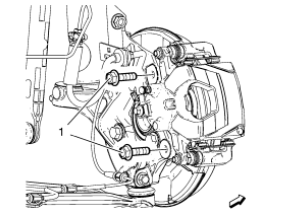
- Install NEW brake caliper bracket bolts (1) and tighten to 100 N·m (74 lb ft) + 60° + 15°..
- Install the tire and wheel assembly. Refer to Tire and Wheel Removal and Installation.
- Lower the vehicle.
- If the brake rotor was refinished or replaced, or if new brake pads were installed, burnish the pads and rotors. Refer to Brake Pad and Rotor Burnishing.
 Power Steering Pump Belt Replacement
Power Steering Pump Belt Replacement
Special Tools
CH 49800 Installer Power Steering Pump Belt
For equivalent regional tools, refer to Special Tools.
Removal Procedure
Caution: Do not use belt dressing on the drive belt. Belt dressin ...
 Front Wheel Drive Shaft Replacement - Left Side
Front Wheel Drive Shaft Replacement - Left Side
Special Tools
CH-313 Slide Hammer
CH-6003 Axle Shaft Remover
CH-46376 Holding Wrench
CH-49400 Hub Spindle Remover
DT-6332 Seal Protector
EN-956-1 Extension
For equivalent regional too ...
Other materials:
Overview
Read the following pages to become familiar with the infotainment system features.
WARNING
Taking your eyes off the road for extended periods could cause a crash resulting
in injury or death to you or others. Do not give extended attention to infotainment
tasks while driving.
The infotainment ...
Tyre Repair
Warning:
Tire changing can be dangerous and should be done by trained professionals
using proper tools and procedures. Always read and
understand any manufacturer's warnings contained in their customers literature
or molded into the tire sidewall.
Serious eye and ear injury may result from no ...
Airbag System
The vehicle has the following airbags:
• A frontal airbag for the driver.
• A frontal airbag for the front outboard passenger.
• A knee airbag for the driver.
• A knee airbag for the front outboard passenger.
• A seat-mounted side impact airbag for the driver.
• A seat-mounted side impac ...
